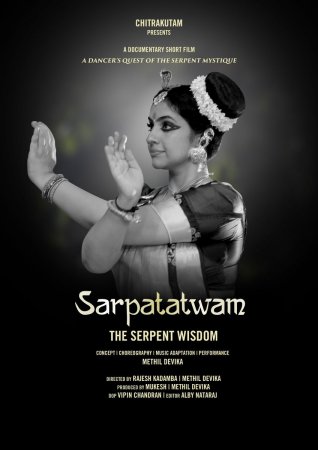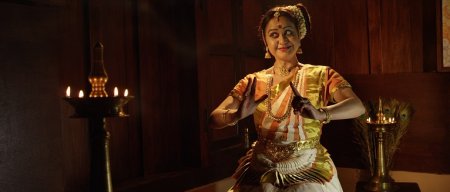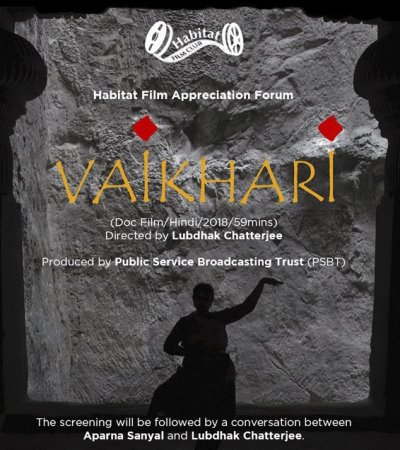
|   |

|   |
 e-mail: sunilkothari1933@gmail.com Sanchari Festival of Films on Dance 2019 Photos courtesy: Loud Applause March 5, 2019 Hot on the heels of Kalavardhini’s 40 years Parikrama in honour of Dr. Sucheta Chapekar’s 70th birthday at Pune, Kalavardhini arranged a two day festival of films on dance in collaboration with Pune’s National Film Archive of India, and Loud Applause, on 16th and 17th February in two sessions a day. This was the second year of their screening of films on dance. The venue is one of the finest film halls with latest state-of-art facilities, excellent projection and acoustics. Being national film archive theatre, it is very clean, neat, sound proof and with best facilities for projection. Thereby it adds to the pleasure of watching the films. It was a pleasure meeting the present director Prakash Magdum, who has been in office the last four years. Kalavardhini’s backbone are Bharatanatyam exponent Dr. Sucheta Chapekar, along with vocalist Pandit Sharad Sathe and Rajani Dandekar of Camlin Ltd. Sucheta firmly believes that in order to increase appreciation of performing and plastic arts, it is important to strengthen links between life and art. She has for the past 30 years worked towards all encompassing medium of dance. Her daughter and disciple Arundhati Patawardhan has been of great help to Kalavardhini in translating its motto: ‘Art for Art, Art for Life, Art for self.’ Today in Pune Kalavardhini has a dedicated community of dancers who have not only created high quality productions but also launched new projects which have substantially contributed in increasing audience for classical arts. Kalavardhini has 35 centres all over the country and also abroad. The co-organizer was a bi-monthly dance magazine Loud Applause. Started by Neha Muthiyan, a Kathak dancer and a disciple of Guru Shambhavi Dandekar, the e-magazine aims at dancers gaining knowledge of various allied arts like music, theatre, various dance forms, and health. It was heartening to see a full house, with dancers, art appreciators and Puneites gather in large numbers. Sukanya Kulkarni-Mone, a noted film and theatre personality, has studied Bharatanatyam under Sucheta. It was obvious that her passion for dance and dance drama had kept her in touch with classical dance events and her guru. She spoke in her inaugural address about the need for interest in various arts and how best films as a medium can reach large audiences.  Sarpatatwam The first screening was by Mohiniattam dancer Methil Devika. She has co-directed the film Sarpatatwam with Rajesh Kadamba, a young film director who was also present during the screening and took part in post screening discussion. Devika is known for her outstanding Mohiniattam performances and well deserved awards like SNA’s Bismillah Khan Yuva Pursakar and Kerala Sangeet Natak Academy’s award. Her venture to co-direct the film is another feather in her cap. Sarpatatwam or The Serpent Wisdom is a dancer’s portrayal of serpent allure through synthesis of music, movement, mysticism and visual art. The serpent has long held the fascination of numerous cultures which imbues it with god-like qualities; the serpent is both feared and worshipped. Through Mohiniattam and indigenous esoteric symbols, the dancer interprets the universal serpent philosophy laid out by 11th century seer physician called Pambatti Siddar. As the serpent unfurls and glides through mysterious spaces, one is transported to another time, where there is nothing left but the primordial. This concept note is further developed in the visual, where Devika is seen using both arms in serpentine, gliding and unfurling movements, performing Mohiniattam in a structure resembling an outhouse temple in a palace, to the singing of the song in praise of the serpent. At times in a close up, we see the pupils of her eyes coming closer, with upheld arms in a manner of a hood of a serpent, in a striking image. The camera moves frontally except when a top angle is taken when Devika performs on the stunning image of a floral design created for performance; as in Bhagavati cult, the drawing is later on rubbed off. When the singing refers to serpent who is a couch for Lord Vishnu, and the serpent bears the globe of universe on its hood, the significance of Sarpatatwam gets further illumined. Devika in post screening discussion explained that this ritualistic performance required the team to observe fast for 21 days, to cast off all impurities. Even the cameraman observed the fast. Devika was invited to perform this choreographed number in two temples where snake worship is prevalent. It was for her a mystical experience. In the film, a foreigner Ian Seth, presently studying Koodiyattam and Teyyam, is shown in conversation with Devika and asks questions about the Sarpatatwam. Devika explains it in terms of philosophy as expounded by Pambatti Sidddar and related aspects of serpent worship, the mystical experience and consciousness of another time to which she gets transported. Devika also explained that she wanted through the film to bring out several layers in dance, which in a normal theatre performance one cannot grasp. In that sense the film is an additional instrument to enlighten the philosophy. Thinking out of box, Devika believes in expanding the themes of Mohiniattam and not limit it to padams and songs of Swati Tirunal. She has been exploring other composers’ kritis like Muthuswami Dikshitar’s on Shakti. This is a welcome attempt as the form need not be limited to expressions of love, shringara, between nayaka and nayika. It is a fascinating topic. The scripting and direction along with co-director Ramesh Kadamba is flawless and engages attention of the viewers. Many years ago this song in Pantuvarali raga used to be danced by the renowned dancer Kamala Laxman. Her serpentine movements amazed audiences. However, Devika has moved several steps ahead using this song for Sarpatatwam, elucidating the theme with its philosophical resonances. Sucheta Chapekar made observations about the various ritualistic practices relating to serpent worship. She said there were 35 types of serpents in Maharashtra. Also she mentioned the worship of serpents during Nagapanchami. In Kerala there is preponderance of serpent worship, sarpa kavu-s are found in corner of the houses in villages where people offer worship to serpents. Lubdhak Chatterjee, who screened his film on padhant, recitation in Kathak of mnemonic syllables, bols, titled Vaikhari, later on spoke of story of Manasa, serpent Goddess popular both in Bengal and Assam. In Oja Pali form of Sattriya dances often dancers present story of Manasa. The film received very good response. In particular, the young dancers learnt lot not only about Mohiniattam dance form but also the fresh horizons it extends in terms of themes and its philosophy.  Mrinalini Sarabhai: The Artist and Her Art I screened the film on Mrinalini Sarabhai: The Artist and Her Art made by Mallika Sarabhai and young filmmaker Yadavan Chandran, son of well-known film director T.V. Chandran of Kerala. He has been working as a director of Darpana’s documentary and communication section at Ahmedabad for past 18 years in close collaboration with Mallika and has produced several documentaries. Both Mallika and Yadavan had a challenge to use old recordings of Mrinalini’s dances. When they started the film, Mrinalini was 94 and naturally she could not perform as she could when she was young. The solution was sought by recreating the choreographic works of Mrinalini under her supervision, by Mallika. In a small studio, Yadavan managed to film the re-choreographed works and at several places Mrinalini herself introduced the works and in some places Mallika drew attention to vast topics Mrinalini has covered. Trained by legendary gurus in Kathakali like Kunju Kurup and in Bharatanatyam by Pandanallur Meenakshisundaram Pillai, Muthukumaran Pillai and Kittappa Pillai, Mrinalini mastered the technique competently. But she was a thinker and a modern woman, with a background of a family, where her father was an eminent lawyer and mother a member of Parliament; she was married to space scientist Dr. Vikram Sarabhai and her in-laws were freedom fighters, the industrialists Sarabhais, who were liberal and believed in arts, including performing arts. By the time we achieved independence, dance was accepted as an art form, but in conservative Gujarat, when Mrinalini after marriage with Vikram Sarabhai came to Ahmedabad in 1947, there was little knowledge about Kathakali and Bharatanatyam. Like her senior contemporary Rukmini Devi, Mrinalini also worked towards establishing dance as an art form worthy of practice. She established Darpana Academy of Performing Arts in Ahmedabad in 1948. She gave several performances creating an awareness of the South Indian classical dance forms. At the same time she also started presenting speculative thoughts of Upanishad, mythological stories and social themes. Mrinalini had studied dance for three years at Shantiniketan and was much influenced by the philosophy of Gurudev Tagore. She had participated in dance-dramas like Chandalika and was aware of how Gurudev believed in treating all humans alike; be they Dalits or untouchables, he broke all those prejudices through his excellent dance-dramas like Chandalika and Tasher Desh. Mrinalini choreographed Chandalika extending the issues prevalent in Gujarat and all over India about untouchables. She took up issues of dowry deaths, environment, her concern about Silent Valley project to save trees, forest in Kerala, took up challenge of producing dance choreography of science, geometry, Pythagoras formula, pollution of river Ganga, and several other issues through dance. Her major work Manushya in 1949 gave indication that she was working towards modern contemporary dance, using the traditional dance forms - the simple story of man looking at his own image as a child in water, looking at his arm which can move, his growing up, marriage, family and finally death. It was danced by Chatunni Panicker in Kathakali minus traditional costumes and makeup. Mrinalini had shown the way traditional dance forms can be artistically used to convey the message. Her majority of productions have been shown in the film as re-choreographed and well filmed by Yadavan. Mrinalini herself in the end shows abhinaya to Krishna nee begane baro. The film is superbly crafted and covers major choreographic works of a legendary dancer. Mrinalini passed away in 2017 and during her centenary celebrations the film has been screened in major cities of India. The response of the young generation has been very encouraging .The Public Services Broadcasting Trust (PSBT) has produced it and it is available in form of DVD from them. It is a rare documentary and needs to be in collection of all educational institutions to acquaint next generation of dancers about a visionary dancer, thinker and poet. In post screening discussion, Sucheta Chapekar observed that it was through this film that she came to learn a lot about Mrinalini Sarabhai’s works. She also said that we all know various issues Mrinalini has shown in dance and that it is possible to deal with social issues, even if we do not have solutions for social evils. The film succeeds in creating an awareness of such issues.  Nilima The third film screened was by Mohiniattam dancer Ayswaria Wariar titled Nilima, Beyond the blue... An exploration. Ayswaria received training in Bharatanatyam under Sucheta and Mohiniattam under Udyogmandal Vikraman and Kalamandalam Saraswathi. She studied Sopana Sangeetam under Kavalam Narayana Pannickar. She runs Nrityodaya Charitable Trust in Vadodara. Ayswaria has conceptualized, visualized and directed the film that is based on a poem by V.Madhavan Nair, author of more than 50 works and Kathakali classic Karnasapatham. The poem is about the true essence of colour Blue. Exploring the creative space between the lines, the film expresses a dancer's story, the story of her search for sublime Nilima. The film is a visual poetry and explores the subtle nuances of Blue as a metaphor. Well filmed, it evokes poetic sensibilities. Ayswaria in post screening discussion explained how as a dancer she was drawn to the poem and how it evoked images which she attempted to explore keeping close to the poem. The film has been screened at many festivals, winning special jury award at the Eastern Global Short Film festival. The organizers had also arranged screening of a vintage popular film Navrang by V.Shantaram, starring Sandhya and Mahipal. It looked anachronistic and out of date as a film to be screened after the films on dance. It seems that the organizers thought that after the documentaries on dance, audience should have some entertainment seeing a feature film on dance with a story. I could not watch it for more than some twenty minutes as what one saw in terms of dance looked unimpressive to the audience too. There were other considerations. Kalpana by Uday Shankar was shown previous year. And Jhanak Jhanka Payal Baje has been often screened at NFAI. Therefore, it seems NFAI director Prakash Magdum suggested the screening of Navrang. However, I think that screening of such films after dance documentaries defeats the purpose of sensitizing the young generation. I do hope next year the organizers would be careful in selecting the film to be screened after dance documentaries.  Vaikhari Since I had to leave next day, I requested Lubdhak Chatterjee to screen the film Vaikhari on laptop. Lubdhak Chatterjee is an independent filmmaker currently based in Delhi. He pursued his Masters degree in engineering but his love for different art forms found its confluence in cinema which he considers his passion. His first short film titled Free State (2016) was screened nationally and internationally, with a premiere at Short Film Corner segments of Cannes Film Festival. He was also associated with The Times of India as a blogger. Vaikhari is his first non-fiction film. The film deals with abstract concept of sound, the recitation of bols, mnemonic syllables called padhant in classical Kathak dance form. Lubdhak was fascinated by the accompanying bols and its tonal qualities and textures of the sound. He visited Mahagami Gurukul in Aurangabad and met its director Kathak dancer Parwati Dutta. He stayed at Mahagami to imbibe the spirit, atmosphere, watch dance practice, playing upon percussion instruments and relishing the padhant. At various intervals he visited Mahagami and in consultation with Parwati Dutta he planned to make a film on padhant and NOT a film on dance, though dance was to be an integral part of the film. The film explores various levels, atmosphere at Mahagami, listening to sounds of padhant, and after evoking special atmosphere conducive to his feelings, he filmed actual padhant recited by Parwati and how she transmitted it to her disciples while training them in dance. They sat together with the pakhavaj, tabla and sarangi players and explored various aspects of padhant. Parwati composed dance on Kalidasa’s Meghadootam for story line, but it was a mere peg. Occasionally Lubdhak filmed dance to enhance the abstraction of bols. Various intra forms like tode, tukde, aamad, paran, and parmelu were demonstrated. In one sequence the pakhavaj, tabla and sarangi players and Parwati engage in conversation and how the bols are played to maintain laya. Those familiar with Kathak dance would easily follow the attempt to show what padhant is. It is by visualization that at times through silence, blank screen, Lubdhak has attempted to capture the essence of padhant. Ellora being the nearest architectural monument, Lubdhak filmed some dance sequences there to explore padhant. It is always a great temptation for a flmmaker to explore visuals of a monument like Ellora. Since the emphasis was not on filming dance with such exquisite backdrop, somewhere the point was still made for abstraction of sound. The aamad, paran like dha taka dhunga, dhagi dhege ta, dha dhinna ta, dhitta ta kida dha, takka thunga was well spoken, played on pakhavaj, tabla and it was interesting to record a parmelu with different bols of sounds of birds, of ankle bells, of percussion instruments, and challenges to play some sound on tabla by just suggesting the rubbing of tabla to approximate the sound. The stanza of Meghadootam was ascribed on a sheet of paper with translation in English, which linked up with the visuals of monsoon or raindrops. The film succeeds in evoking these in cinematic language. Lubdhak is interested in exploring through film medium abstract concepts which to some extent succeed and the configuration of sound, music, and atmosphere, work out very well. I would have loved to learn responses of dancers to this film as majority of young Kathak dancers were attending the screening. Sanchari is a very good festival for creating awareness about film as a medium to compliment dance. The attempts made in recent times by two leading dancers, Alarmel Valli for her two films viz., Pravahi by Arun Khopkar and Lasya Kavya by Sankalp Meshram on her dance, and Unseen Sequence on Malavika Sarukkai by Sumantra Ghoshal, are good examples. If these films have not yet been screened, they could be included in the 3rd edition of this festival. .  Dr. Sunil Kothari is a dance historian, scholar, author and critic, Padma Shri awardee and fellow, Sangeet Natak Akademi. Dance Critics' Association, New York, has honoured him with Lifetime Achievement award. Post your comments Please provide your name and email id when you use the Anonymous profile in the blog to post a comment. All appropriate comments posted with name & email id in the blog will also be featured in the site. |